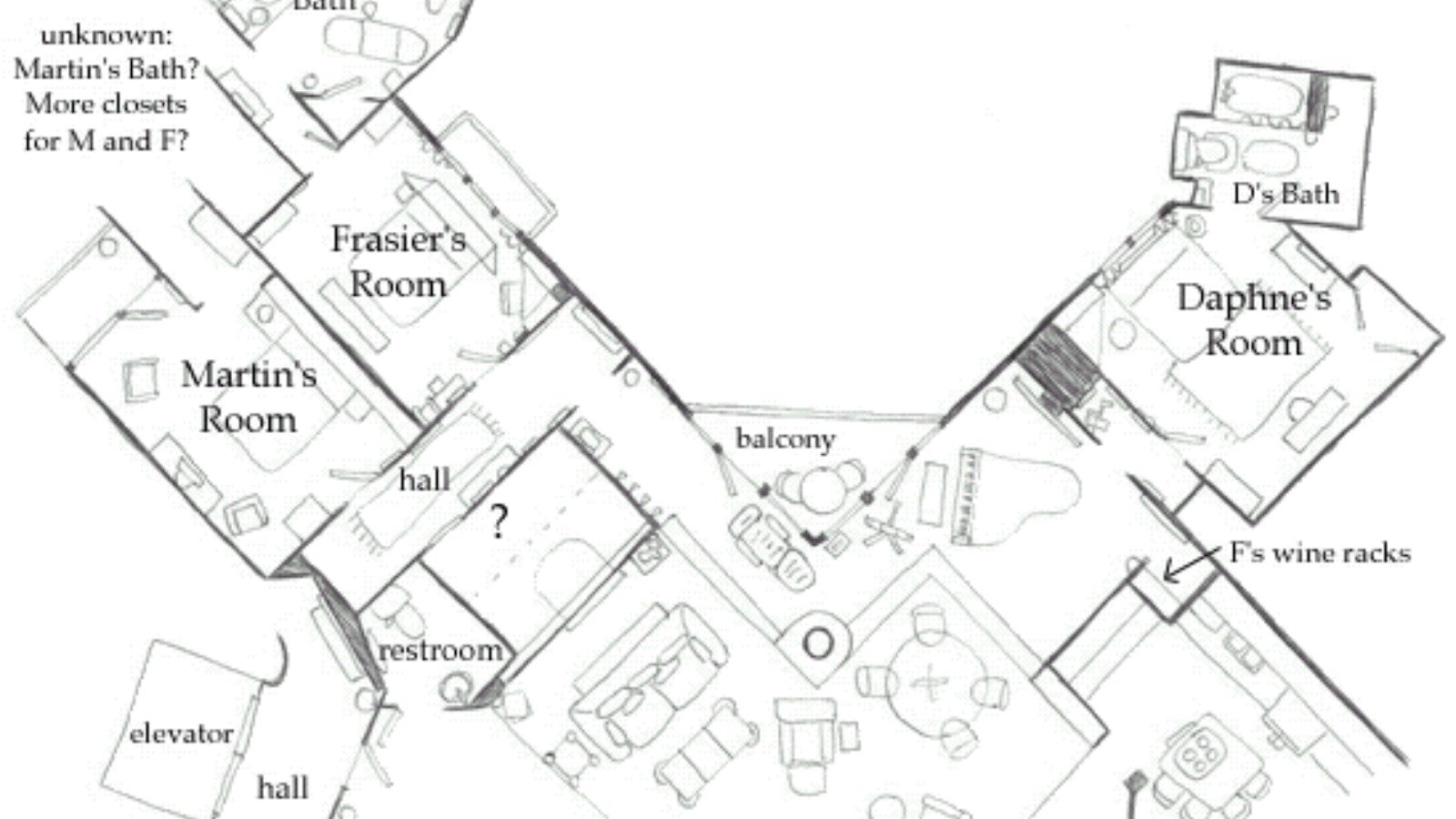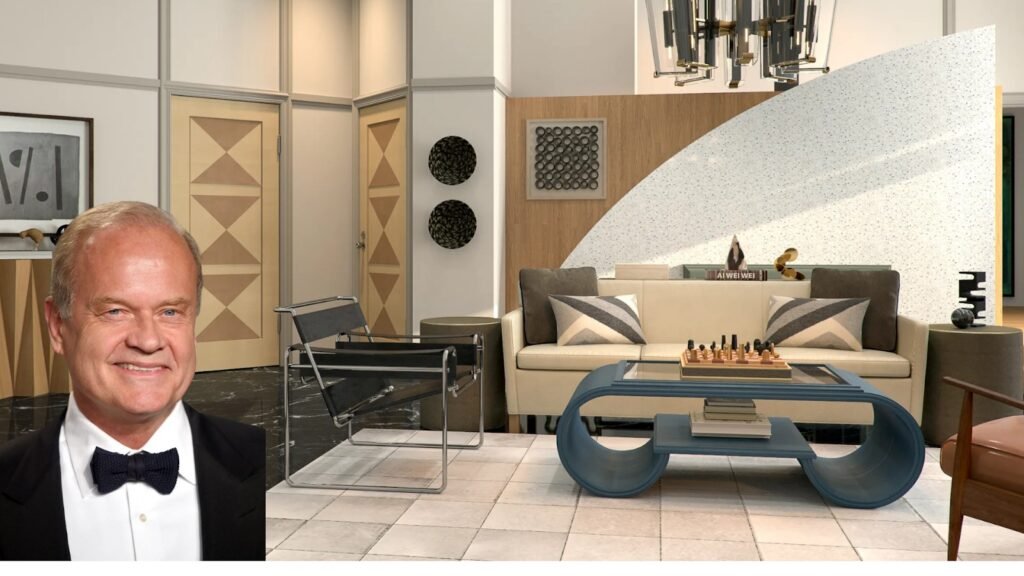I’ve always been fascinated by television sets that feel like real homes. Frasier Crane’s Seattle apartment is one of those special places. The show ran for eleven seasons, and that sophisticated space became as memorable as the characters themselves.
The apartment wasn’t just a backdrop. It told us everything about Frasier’s refined taste and intellectual pretensions. Every piece of furniture, every art object, every carefully chosen color spoke volumes about who he was.
Frasier’s expensive taste met his father’s practical needs. The result was a home that felt both aspirational and accessible.
You’ll learn about the actual layout of this famous fictional home. We’ll walk through each room together. I’ll show you the design choices that made it so distinctive. Plus, you’ll get tips on recreating that timeless look in your own space.
The Location and Context of Frasier’s Apartment
Set in Seattle’s Elliott Bay Towers: The apartment sits in the fictional Elliott Bay Towers, capturing Seattle’s upscale waterfront atmosphere. Those sweeping views of the Space Needle and Puget Sound became the show’s visual signature.
Penthouse Vibes with Urban Sophistication: This high-rise luxury setting perfectly matched Frasier’s refined personality. Floor-to-ceiling windows and an open layout created an expansive, modern feel that reflected his psychiatrist’s income and cultured lifestyle.
A Walkthrough of the Apartment Layout

Entryway and Living Room
The front door opens directly into the main living space. No separate foyer here.
The living room dominates the apartment. It’s where most scenes take place. The famous Eames chair sits prominently. Martin’s ugly recliner creates visual tension nearby.
A baby grand piano occupies one corner. The dining table sits between the living area and the kitchen. Those massive windows frame the entire space with Seattle’s skyline.
The Kitchen
Small but perfectly functional. The kitchen connects seamlessly to the living area.
It’s where Frasier makes his morning coffee. Where he and Niles discuss their elaborate meals. The space feels efficient rather than spacious.
A breakfast bar separates the kitchen from the dining area. The design keeps the cook connected to guests and family.
The Hallway & Bedrooms
A hallway leads from the living room to the private spaces. It’s narrow but serves its purpose.
Frasier’s master bedroom sits at the end of the hall. We rarely see inside, but it’s the largest bedroom. The guest room becomes Martin’s space when he moves in.
The hallway creates privacy without wasting space. It’s a practical design choice that works well for the apartment’s size.
The Balcony
Not always visible, but crucial to the show’s atmosphere.
The balcony provides those iconic city views. Characters step outside for important conversations. It’s where Frasier contemplates life’s big questions.
The outdoor space extends the apartment’s living area. It brings Seattle’s beauty right into the home.
Bathroom & Other Spaces
The main bathroom stays mostly hidden from view. We catch glimpses during certain episodes.
There’s likely a powder room for guests. Storage spaces exist but aren’t prominently featured. The show focuses on the social areas where characters interact.
These unseen spaces add realism to the layout. They make the apartment feel like a complete home.
Iconic Interior Design Choices
Mid-Century Modern Style
The apartment showcases clean lines and minimal ornamentation. This design philosophy dominated the entire space.
Neutral colors create a sophisticated palette. Beiges, creams, and warm grays appear throughout. The furniture features smooth curves and quality materials.
Every piece looks intentional. Nothing feels random or thrown together. The style reflects Frasier’s educated taste and professional success.
Martin’s Recliner vs. Frasier’s Taste
This design clash drove countless episodes. Martin’s beat-up recliner horrified Frasier’s refined sensibilities.
The contrast was brilliant storytelling. Frasier’s expensive furniture met his father’s practical comfort. The recliner represented everything Frasier tried to avoid.
Yet the chair stayed. It became a symbol of family compromise. Sometimes love matters more than perfect design.
Art, Sculpture, and Collectibles
Frasier’s apartment showcased his cultural interests. African masks lined the walls. Sculptures occupied prime real estate.
The famous “Ekor” statue became a running joke. Books filled every available shelf. Classical music albums are displayed prominently.
These objects weren’t just decorations. They revealed Frasier’s personality. His pretensions. His genuine appreciation for culture. His need to impress others.
Can You Recreate Frasier’s Apartment?
Floor Plan Sketches and Fan Theories: Devoted fans have created detailed floor plans based on the show’s footage. These reconstructions help visualize the complete layout.
Online communities debate the apartment’s exact dimensions. Some fans have built scale models. Others create digital recreations using design software.
Design Tips to Get the Look:
- Choose a neutral color palette with warm undertones
- Invest in quality furniture with clean lines
- Add cultural artifacts and meaningful art pieces
- Keep window treatments minimal to maximize natural light
- Include a piano or other musical instruments
- Display books prominently throughout the space
- Mix textures through throw pillows and area rugs
- Add plants for natural elements
- Choose statement lighting fixtures
- Keep clutter to an absolute minimum
Fun Facts and Easter Eggs
- The African statue “Ekor” appears throughout the series as a fertility symbol. This creates subtle irony given Frasier’s romantic struggles.
- Set designers shopped in actual Seattle stores for authentic pieces. This attention to detail made the apartment feel genuinely Pacific Northwest.
- The apartment’s layout occasionally defied logic. The balcony seemed to move sides between episodes. The kitchen changed size depending on scene requirements.
- Book titles often matched episode themes. The artwork shifted to reflect storylines. Even wine bottles told stories about character development.
Conclusion
Frasier’s apartment remains one of television’s most memorable spaces. It perfectly captured the character’s sophisticated aspirations and genuine warmth.
The design choices created a timeless look that still feels fresh today. Mid-century modern furniture. Neutral colors. Cultural artifacts. These elements combine to create something truly special.
The apartment proved that sets can be characters too. It reflected Frasier’s personality while providing the perfect stage for family dynamics. The space felt lived-in and loved.
Whether you’re a longtime fan or new to the show, this apartment continues to inspire. Its blend of comfort and sophistication offers lessons for anyone creating their own space.
Frequently Asked Questions
Was Frasier’s apartment based on a real Seattle location?
No, Elliott Bay Towers is fictional. However, the designers used real Seattle views and local furnishings to create an authentic Pacific Northwest atmosphere. The attention to local detail made the setting feel genuinely rooted in Seattle culture.
How much would Frasier’s apartment cost in real life?
Based on the size and location, a similar Seattle penthouse would likely cost $2-4 million today, with monthly rent around $8,000-15,000. Seattle’s real estate market has only made such luxury spaces more expensive since the show’s era.
Did the apartment’s layout stay the same throughout all seasons?
The basic layout remained consistent, but minor changes occurred for practical filming reasons and to keep the set feeling fresh. These subtle modifications were so skillfully done that most viewers never noticed the differences.
Can I buy furniture like Frasier’s?
Many pieces were mid-century modern classics. The Eames chair and similar furniture are still available from design retailers, though authentic vintage pieces command premium prices. Reproductions offer more affordable options for achieving the same sophisticated look.
What happened to Martin’s recliner after the show ended?
The actual recliner used in the filming was auctioned off to collectors. It became one of the most sought-after pieces of TV memorabilia from the show. The chair’s cultural impact far exceeded its modest appearance and original cost.

